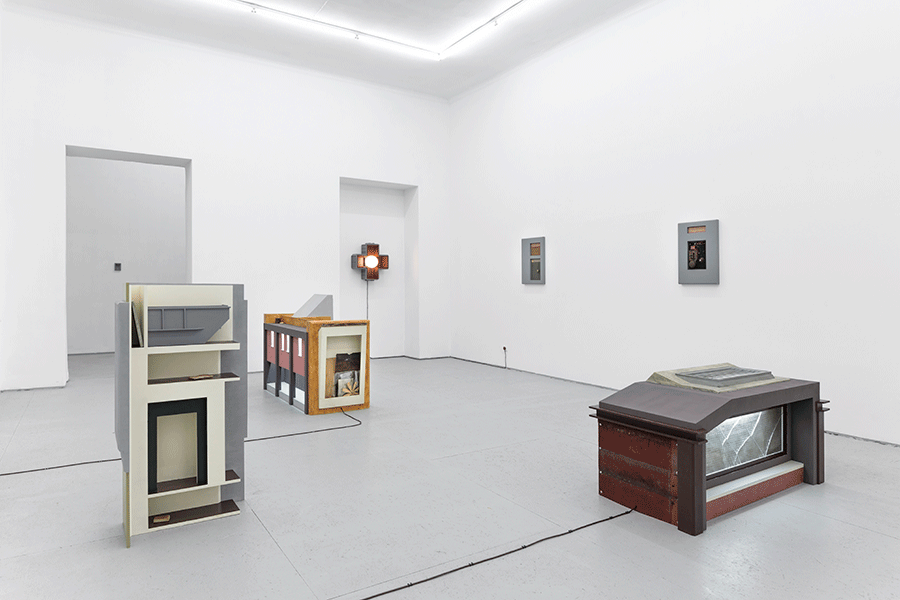Adam Shiu-Yang Shaw’s Impossible Objects
At Wschód, Warsaw, the artist uses digital tools to develop sculptures that confound scale, visual plane and function
At Wschód, Warsaw, the artist uses digital tools to develop sculptures that confound scale, visual plane and function

After seeing ‘What Time Has Left’, Adam Shiu-Yang Shaw’s current solo exhibition at Wschód, I had a short video call with the artist. When he pulled up images from the show on screen, I was surprised to see that many of the bureau-sized sculptures didn’t correspond to my memory of them. Sterile and 3D render-like in photographs, in person, Shaw’s ambiguous sculptural mashups of household items and elements of urban architecture unfold as you orbit them. Like the rabbit-duck illusion, these ambiguous objects can be more than one thing at once.

Take An Interval Between Events (all works 2021), in which a building facade morphs into a shelving unit, an industrial rubbish bin, a bed and basement window vent, triggering a cycle of associations of human existence in the process. City Assembly – an amalgamate of soiled roof tiling, a cracked window illuminated with an eerie electric light, an air-vent panel and a cupboard front repurposed to resemble a waste container – similarly suggests human habitation. As with all of Shaw’s sculptures, these works are built from what the artist tells me are ‘totally exhausted’ items salvaged from the street or bought in thrift stores. Engineered together, however, these worn-out objects form a lively shapeshifting entity that lures you in with some semblance of the homespun only to leave you lost. To create these works, Shaw draws from an ever-expanding library of self-generated photographs of everyday items and elements of urban architecture, as well as the physical items themselves – sourced mostly from Berlin, where the artist is based – and digital tools to develop works that confound scale, visual plane and function. Shaw refers to the resulting bricolage sculptures as ‘extrusions’, implying that his creative process is a form of painstakingly exercised poetry, of innovation as much as nostalgia.

At times, these visual poems are more formally concise, as in the sequence of wall works featuring bells, buzzers and rings (Alarm Device 1, 2, and 3) set against different types of textiles resembling quilted beds and encased in small vitrines of the kind used to display restaurant menus or posters outdoors. These function as tableaux: one showcases a little bell on a chain; the second, a found electric door buzzer; the third features a plaster cast of a broken iPhone, a dead ringer for its original, yet unable to produce any kind of sound. The series leads me to thoughts about wakefulness, anxiety and rest – to the parts of the day heralded by bells and alarm clocks – but also to the contemporary idea of sleep as ‘selfcare’. Other works include different casts: of wallets or key pouches but also of books and notepads where the originals have been inexplicably covered with paper by their former owners. Made in off-white plaster, these cast objects are vexingly inaccessible, denying any interaction, but still compelling in the intimacy they engender. There are also works based on repurposed logos from German pharmacies. In Symptoms and Prescriptions Pt. 2, for instance, a dismantled lightbox in the shape of a Greek cross functions perhaps as a shrine, with a beaconing light at the centre – a dismantling of the idea that we can infinitely restore ourselves like a piece of furniture brought back to life by a skilled craftsperson.

Shiu-Yang Shaw’s archaeology is a compelling one: out of fragments of past and present emerge impossible objects from parallel universes, which speak to our unattainable fantasies of life: an endless process that can be structured, compartmentalized and, whenever necessary, rehabilitated.
Adam Shiu-Yang Shaw’s ‘What Time Has Left’ is on view at Wschód, Warsaw, until 12 February 2022.
Main image: Adam Shiu-Yang Shaw, An Interval Between Events (detail), 2021, installation view. Courtesy: the artist and Wschód, Warsaw























